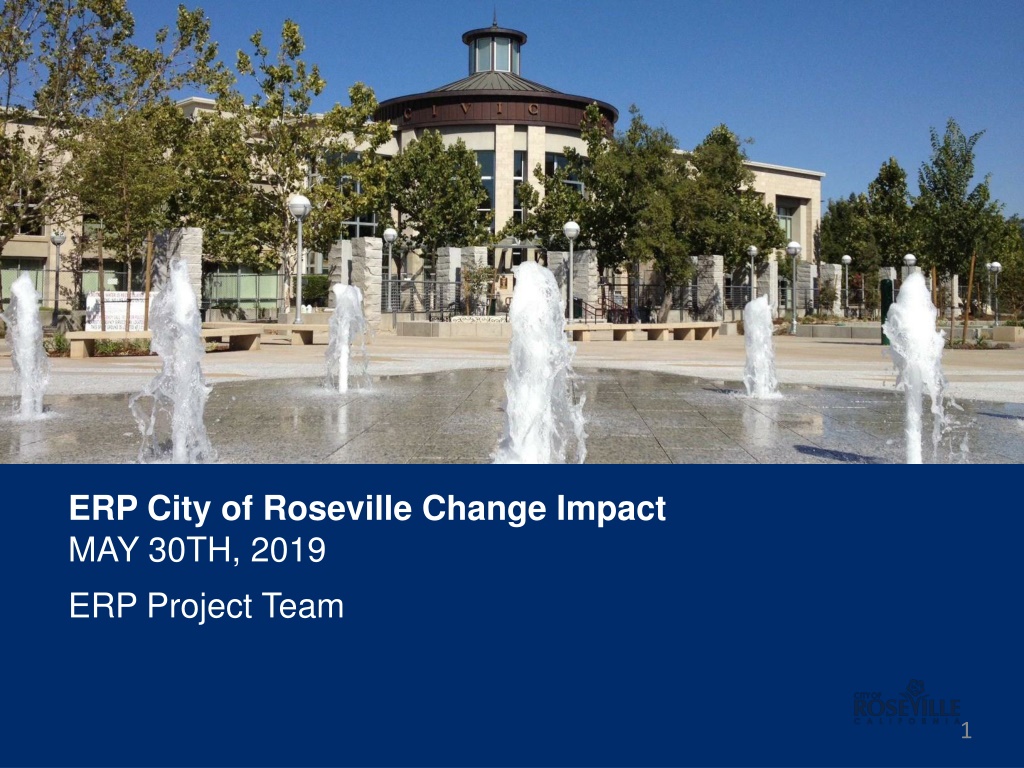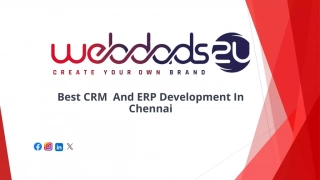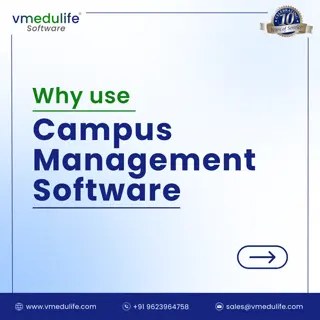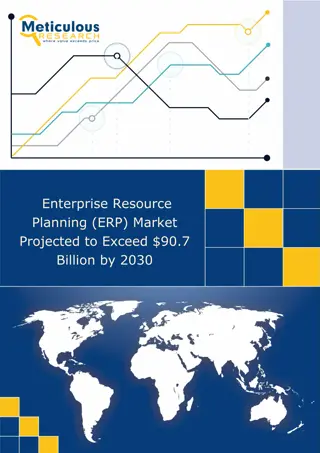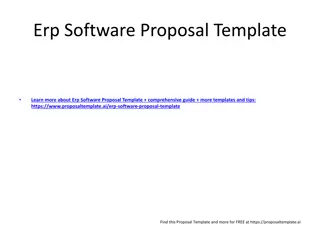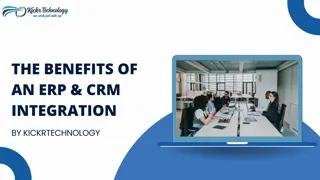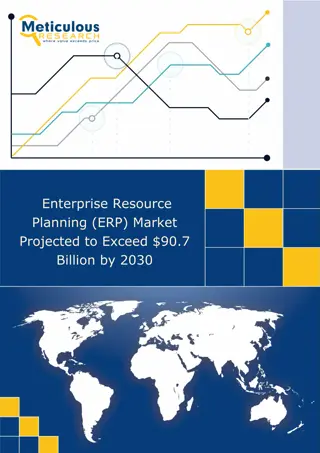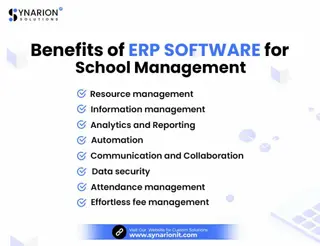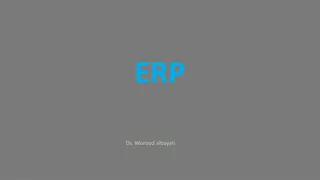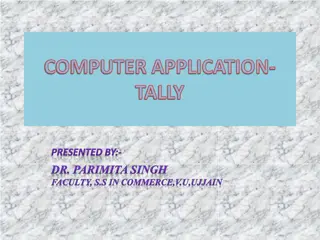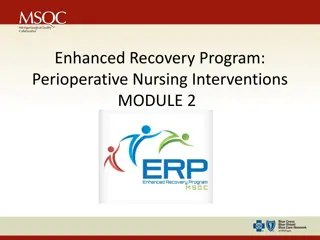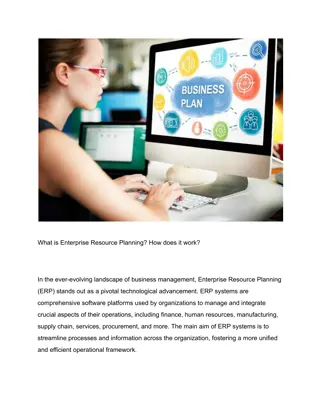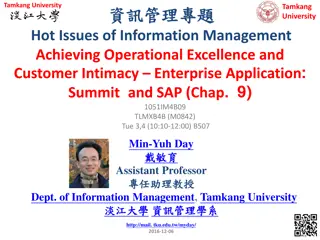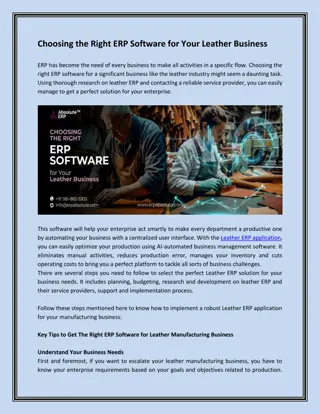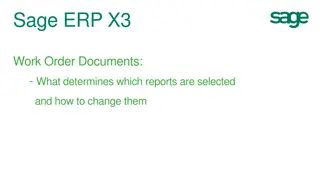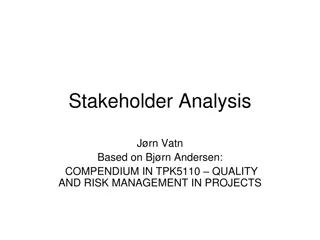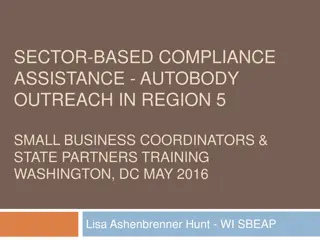ERP Project Overview and Impact Analysis
This document provides a comprehensive overview of the ERP project undertaken by the City of Roseville. It includes details about project goals, benefits, scope, changes, impacts, stakeholders' commitments, and logistics. The project aims to consolidate technology, streamline processes, and enhance efficiency across the city's financial and human resources functions. By adopting best practices and modern technology, the project seeks to improve workforce productivity, reduce manual entries, and provide timely and standardized data for informed decision-making.
Download Presentation

Please find below an Image/Link to download the presentation.
The content on the website is provided AS IS for your information and personal use only. It may not be sold, licensed, or shared on other websites without obtaining consent from the author.If you encounter any issues during the download, it is possible that the publisher has removed the file from their server.
You are allowed to download the files provided on this website for personal or commercial use, subject to the condition that they are used lawfully. All files are the property of their respective owners.
The content on the website is provided AS IS for your information and personal use only. It may not be sold, licensed, or shared on other websites without obtaining consent from the author.
E N D
Presentation Transcript
ERP City of Roseville Change Impact MAY 30TH, 2019 ERP Project Team 1
ERP Business Impacts Agenda Project Goals Project Benefits ERP Project Scope Expected Changes (Finance and HCM Suites) City Departmental Support Team Commitment Go Live Command Center Logistics Open questions and discussion 2
ERP Project Goals Consolidation of technology, processes and people to one Integrated Financial System. Adopt & Go: Adopting best practices into future state processes. Gain People and Technology synergies between departments across the City. Create consolidated and timely reporting across entities and funds. Accommodate One set of Books for Finance and FERC Reporting. 3
ERP Project Goals Reduce redundant manual entries. Improve workforce productivity with streamlined processes and automation. Leverage industry best practices. Modernize technology (Cloud, Mobility, Self Service). 4
ERP Project Benefits Provide a single source of standardized data across the city, with which to benchmark, compare, report, trend, market, analyze, and negotiate on a more timely and accurate basis. Provide meaningful and current information to assist City Manager, Department Heads, Managers and Supervisors in improving operational performance and outcomes. Provide the ability to streamline functions and standardize business processes across the city. Provide for city s enterprise wide consolidated reporting and analysis across multiple cost centers/departments. 5
ERP Project Benefits Reduction of paper processes (e.g., HR transactions, expense reporting) Processing is more efficient Paperwork doesn t get lost in the shuffle Real-time visibility to status of approval workflow Secondary labor will be updated each time payroll is run (versus monthly) In many cases data can be viewed within the system without having to run a report Some processes can be viewed/accessed via mobile devices 6
ERP Project Scope Finance Human Resources/Payroll Reconfigured Workforce Application Manager Self Service Employee Self Service Benefit Enrollment Payroll Impacts Chart of Accounts FERC reporting Journal Entry process Accounts Payable Accounts Receivable General Ledger Asset Management Project Performance Management PPM Invoice Matching & Workflow Process Flow Management Reporting Pcard Expense Report Integrations To/From Oracle Accela, Cayenta, Maximo, Perfect Mind and Daycare Works Rebates and Refunds Time and Attendance (Workforce) Punchout (Office Depot) CalPERS Benefit Vendors ADP Wells Fargo Procurement Purchase Order Purchase Requisition Self-Service Requisition Approval NIGP Commodity Coding Contracts Terms & Conditions Supplier Portal 7
ERP Expected Changes - HR Manager Self Service New Hire Promotions Personnel Actions (Status Change, Schedule Changes) Special Pays (Certificate Pay, Educational Pay) View and Report on Direct Reports Employment Information 8
ERP Expected Changes - HR Manager Self Serve HCM Current (IFAS) Future (ERP) Initiated by a Personnel Requisition Form. Manually routed for approval. Recruitment Process NO CHANGE New Hire (Pending Worker) info input into ERP by Manager or Department Administrator; Electronic work flow approval to Department Head and HR. HR sends candidate Pre-Employment paperwork. Personnel Transaction routed manually for approval; Managers have candidate fill out pre- employment testing paperwork and route to HR New Hire Personnel Transaction routed manually for approval. ERP input by Departments with electronic work flow Promotion 9
ERP Expected Changes - HR Manager Self Serve HCM Current (IFAS) Future (ERP) Status Change (Schedule Change, Manager Change, Transfer) ERP input with electronic work flow Personnel Transaction Employee uploads Certificate document with electronic approval work flow. Certificate/ Educational Pay Certificate Pay Form routed manually for approval Departments assign employees to Positions in ERP. Position control allows for a position to be filled in different ways (I vs II level). Vacancy reports available to department. Allocation Schedule is manually monitored by HR. I/II levels not related on schedule making monitoring and vacancy list development a very manual process. Position Control 10
ERP Expected Changes - HR Employee Self Serve Enroll in Benefits View Benefits, Covered Dependents and Coverage Amounts Add/Delete Dependents Add/Delete Beneficiaries for Life Insurance REACH Annual Donation Drive 11
ERP Expected Changes - HR Employee Self Serve Benefits Current (IFAS) Future (ERP) Paper process; HR staff manually reviews enrollment to meet benefit plan rules; HR inputs enrollment in IFAS and up to six vendor systems Employee enrolls for benefits in ERP. ERP configured to meet compliance with benefit plan rules. Enrollment is sent to vendors via interface. Employee enrolls dependents in ERP. ERP configured to meet compliance with benefit plan rules. Enrollment is sent to vendors via interface. Documents can be uploaded in the ERP system. Only HR and the employee will have viewing rights to these documents. Enrollment Employee contacts HR to add dependents. HR manually adds dependent to vendor systems. Dependents Birth Certificates, Marriage Certificates and other documents handed into HR office in person Documents 12
ERP Expected Changes - HR Employee Self Serve Benefits Current (IFAS) Future (ERP) Paper process; Excel spreadsheets developed in the departments and sent to HR for individual entry for each payroll deduction by employee to each charity. Enrollment done in ERP. Payroll deductions automatically set up. REACH 13
ERP Expected Changes - Payroll Workforce will be updated to match the new chart of accounts and will have some additional updates Pay Checks and Stubs will look entirely different Paycheck codes will be more descriptive How your pay is calculated might change by a few cents Our goal is to have employees pay accurate on the first check but some payroll items may still need to be adjusted after go live. We appreciate your patience while we work through any issues that arise. 14
ERP Expected Changes - Payroll HCM Current (IFAS) Matches current Chart of Accounts. Local 39 employees have elapsed times on schedules. Time off Requests are requested in total hours per day. Limited characters for code names. Shows Hours, Pay Rates, Pay Period Totals (Current) and Year to Date pay amounts. Future (ERP) Updated to match the new Chart of Accounts. Local 39 schedules will have in and out times. Time off requests will have to be entered using in and out times. Workforce Codes will be longer and more descriptive. Shows hourly rate, current and YTD pay amounts. Employees will need to reference Workforce for hours paid. Pay Stub or Check 15
ERP Expected Changes - Payroll HCM Current (IFAS) Future (ERP) Calculates total hours per pay period times pay rate. The totals per pay code can cause the totals to round up or down. Calculates hours per day times pay rate. The totals per day can round up or down causing total pay to round up or down. Calculation of Pay 16
ERP Expected Changes - Journals New Chart of Accounts Mapping table is just a starting point, rules will restrict values to valid combinations in Oracle using Cross Validation Rules New Account Code will be provided New Fixed Asset administration regulation will be available in draft status Journal Entry process Departments can prepare journals using new form for Accounting team entry Workflow approval will occur once journal is entered into Oracle View only access provided to review journal and analyze balances New forms will be available and introduced during the GL Inquiry Training sessions 17
Chart of Accounts Current (IFAS) Org Key Object/Project Activity Future (ERP) Fund.Account.Center.Project.Function.Interfund.Future
Chart of Accounts Overview Fund 1001 General 5385 Account Subscriptions 05050 General Accounting Org Key 24101 General Accounting Center 5220 Object Books/Tapes/Su bscriptions Project 000000 Default Project Blank Function 00000 Default Activity Blank Interfund 0000 Default Future 00000 Default
Terminology Terminology Fund Definitions Fund will be an independent accounting entity and a self- balancing unit There will be a Fund Hierarchy representing the Parent Fund (CAFR Fund) and Child Fund (Budget Fund) values. Entry will be at the Child Fund Value only. 1999 General Funds P2 1899 General P1 1001 General Fund Account Accounts will be used to categorize transaction types 7999 Expenses or Expenditures P2 5799 Materials Supplies and Services P1 5385 Subscriptions
Terminology Terminology Center Definitions Center will be used to categorize revenue and expenses/expenditures transactions by a lower level than a Fund (i.e. departments, divisions, programs) There will be a Center Hierarchy representing the Parent Center (Department) and Child Center (Division or Programs) values. Entry will be at the Child Center values only. 24999 Finance P2 24199 Accounting P1 24101 General Accounting
Terminology Terminology Function Definitions Included for tracking purposes (FERC, Bank Accounts, Loans and Debts, Program Tracking) 19999 Bank Accounts P2 10999 USB P1 10001 USB Concentration Used to track transactions that flow across more than one Fund System-generated Interfund Future will be used for a future unidentified purpose System-generated until it is in use Future
HIGH LEVEL PROCESS FLOW JOURNAL ENTRY Accounting uploads JE and submits to workflow Accounting reviews, approves, and posts JE Requester identifies need for JE End-user creates JE on a template End-user sends JE template to Accounting End-user can review JE status
ERP Expected Changes - AR Invoices/Receipts Departments will still fill out paper form to request a bill for non-project invoices There will a separate process for project billings Departments will be able to review AR invoices and receipts including attachments and payment status in Oracle New forms will be available and introduced during the AR Inquiry Training sessions 24
HIGH LEVEL PROCESS FLOW ACCOUNTS RECEIVABLE Dept. can review invoice and payment in Oracle CM CM Dept. submits form with backup to CM generates invoices and attaches backup receives and applies payment to invoice Dept. identifies invoice CM sends invoice to customer CM = Cash Management
ERP Expected Changes - Project Management New, Separate Module for Projects Project Portfolio Management (PPM) Collects project costs, facilitates billing and capitalization New definition for Projects Capital Improvement Projects and Grants only Annual projects become cost centers Tracking projects become function codes Fixed asset capitalization direct tie from project costs Multi-funded projects coded directly to multiple funds Eliminates need for transfers Facilitates capitalization directly in multiple funds Capital vs. Non-capital coding of costs at budget/transaction level Facilitates capitalization Recognizes expenses annually rather than at project end Secondary labor as we know it today only exists in PPM Process for closing projects 26
PROJECTS HIGH LEVEL PROCESS FLOW Project Manager requests new Project Finance awards budget to Project Finance creates new Project Project Manager starts Project Fixed Assets are created Costs are collected in PPM Request Form
ERP Expected Changes - Procurement Purchase Requests (PR s) Change Orders Receiving Contracts Supplier Portal Workflow Approvals Online audit of workflow approvals and online inquiries 28
PROCUREMENT HIGH LEVEL PROCESS FLOW Supplier delivers goods or services and submits invoice Requester or Preparer submits PR and routes for approval Buyer creates PO and provides to Supplier Requester receives items in Oracle AP Invoice routes electronically for approval processes invoice for payment
ERP Expected Changes - Procurement Current (IFAS) Future (ERP) A Preparer may submit a purchase requisition on behalf of the Requester Requesters select a commodity code (NIGP code) used to define the product or service when creating a line item ERP is linked to Office Depot for ordering office supplies directly through Oracle on a requisition. A PO is automatically generated. Supplier Portal offers the option of structured supplier communication through a secure, internet-based portal with Supplier access 24 x 7 Requesters initiate a purchase requisition Commodity codes are not used when creating a line item Purchase Requests Users order directly from Office Depot No Supplier Portal option is available. Supplier communications occur via phone, email or mail. Supplier Portal 30
ERP Expected Changes - Procurement Current (IFAS) Future (ERP) Buyers send PO s to Suppliers and Suppliers acknowledge acceptance of PO s via email Suppliers with Supplier Portal account can acknowledge acceptance of PO s (quantity, price, delivery) via Oracle Purchase Orders Purchase Order number is the same as Service Agreement number Multiple PO s may be linked to one Contract Purchase Agreement (CPA), with all having different numbers Requestor process change orders via Oracle and Buyer approves End-users email change order requests to Buyers Change Orders 31
ERP Expected Changes - Procurement Current (IFAS) Future (ERP) Receiving Purchase Orders Receiving of goods and services is completed by the Purchasing Division Receiving of goods and services is completed by the end-user Electronic signature for Contract Purchase Agreements (CPA s) below the Council limit. Handwritten signature on all levels of agreements. Contracts Workflow is established by department/division and varies across departments. Must select a code to define workflow path Workflow will route to Requester s supervisor/manager and others can be added as needed Workflow Approval 32
ERP Expected Changes - Accounts Payable Invoice scanning and coding Coding of invoices against multiple funded projects Invoice workflow approvals (PO vs Non-PO) Invoice payment viewing Expense report reconciliation and approvals PCard managed within Oracle vs. Wells Fargo website 33
ERP Expected Changes - Accounts Payable Current (IFAS) Future (ERP) Suppliers submit hard copy invoices City end-users email or interoffice invoices to AP NO CHANGE Submitting Invoices City end-users scan and submit invoices to AP via Oracle email Coding Invoices Invoices are coded manually Invoices will be coded manually Invoices manually route for approval Workflow varies across departments Invoices electronically route for approval via Oracle Requestor to line Manager for approvals New suppliers complete self- registration OR City end-user can submit a New Supplier Request Suppliers are assigned an NIGP code (commodity code) that define the product or service provided by the Supplier Workflow Approval Invoices New suppliers are entered in City database by AP Suppliers Suppliers are not listed with an associated NIGP code (commodity code) 34
ERP Expected Changes - Accounts Payable Current (IFAS) Future (ERP) Suppliers setup with Supplier Portal accounts can view invoices and the status of their payment Expense reports are approved via electronic workflow Suppliers call/email regarding the status of payment Invoice Payment Status Expense reports are approved via paper P-card reconciliation through Wells Fargo website P-card reconciliation through ERP Expense Reports Per diems Workflow Approval Expense Reports Employee to Line Manager, can be delegated to preparer Paper routing 35
ERP City Departmental Support Department Heads, Supervisors and Managers support and endorse the deployment of the ERP Oracle applications and associated training. Gain an understanding of the change impacts between current systems and ERP Oracle cloud applications. Post go live, timely review of workflows will be critical to avoid back log Implement changes operationally related to Chart of Account and Workforce time and attendance impacts. Know the new project numbers Reach out to Train the Trainers within your department for first level of support Reach out to the ERP Team with specific questions and clarifications Attend required training to have access to the system 36
ERP Go Live Command Center Logistics Prior to Go Live: Create Command Center for HCM & Finance ( Logistics/Phone) Staff the Command Center (City, ERP Team and Volunteers) Define 1st and 2nd Level support process Communicate key messages Create Training Labs 37
ERP Team Commitment & Support Post Go Live Date Period Support ERP team will remain engaged for a smooth transition Provide support thru the first month close Post implementation phase continues for approximately 30 days after go live thru July 31st, 2019 Training labs for drop-in for hands on exposure CherryRoad consultants roll off August 1st with the exception of few still working on open issues Continuing Support City IT/ERP team will continue to support end users as needed CherryRoad to provide 11 month post production support to ERP team Business and functional issues will be supported by ERP business/IT analysts 38
